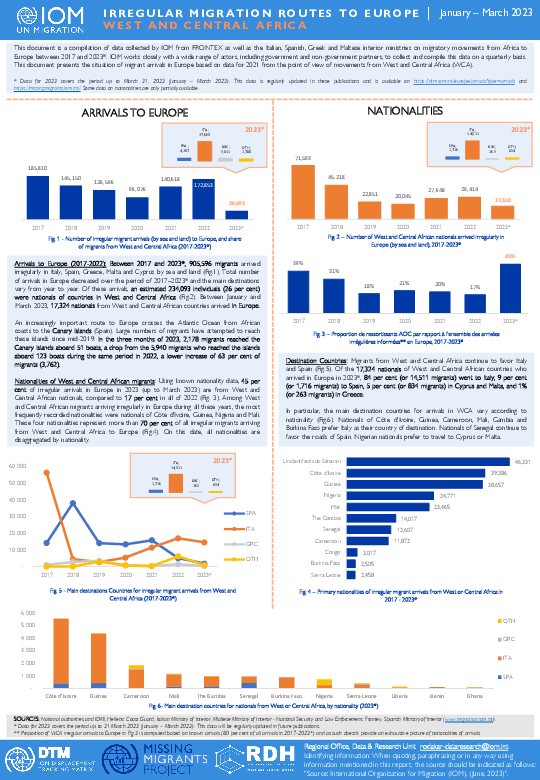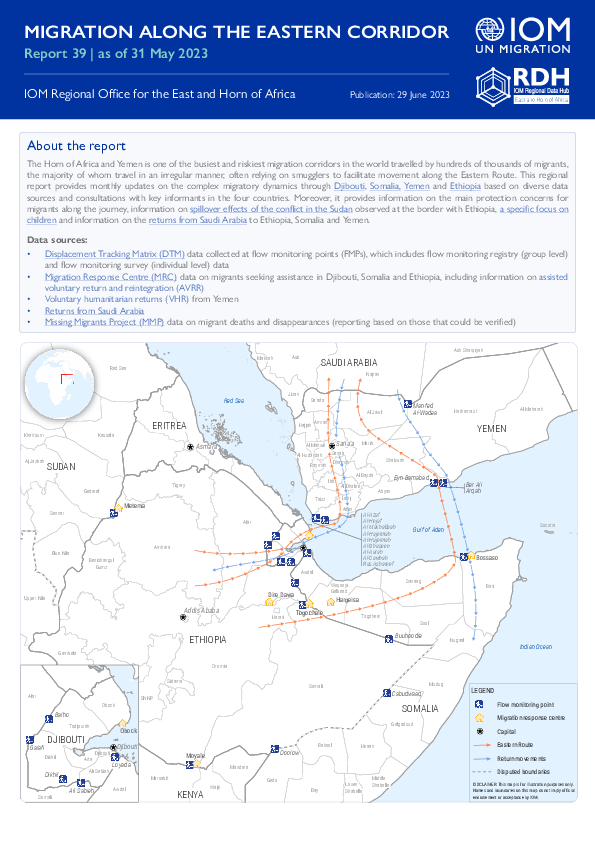-
Countries
-
Data and Analysis
-
Special Focus
-
Crisis Responses

Contact
DTMAfghanistan@iom.int
Language
English
Location
Afghanistan
Period Covered
Sep 01 2022
Dec 31 2022
Activity
- Mobility Tracking
- Site Assessment
- Baseline Assessment
DTM has been conducting the Baseline Mobility Assessment (BMA) in Afghanistan since 2016 to track mobility, provide information on population estimates, locations and geographic distribution of displaced and returnee populations, reasons for displacement, places of origin and periods of displacement. The Community-Based Needs Assessment (CBNA) provides a comprehensive overview of the evolving vulnerabilities and multisectoral needs in communities hosting internally displaced persons (IDPs) and returnees from abroad.
Data is collected at the settlement level through focus group discussions with community focal points and direct observation. The figures presented in the report are estimates provided by community focal points.
This factsheet delves into the key findings in Herat province using the latest results from Round 16 (Sep to Dec 2022) of the BMA and CBNA, focusing on the 2021-to-2022 period.
The full report can be found here: Baseline Mobility Assessment and Community-Based Needs Assessment.
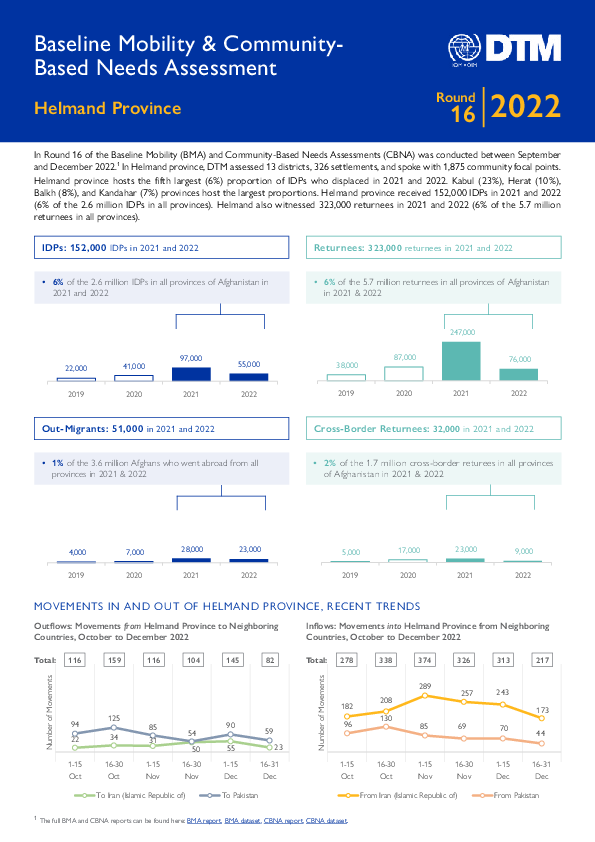
Contact
DTMAfghanistan@iom.int
Language
English
Location
Afghanistan
Period Covered
Sep 01 2022
Dec 31 2022
Activity
- Mobility Tracking
- Site Assessment
- Baseline Assessment
DTM has been conducting the Baseline Mobility Assessment (BMA) in Afghanistan since 2016 to track mobility, provide information on population estimates, locations and geographic distribution of displaced and returnee populations, reasons for displacement, places of origin and periods of displacement. The Community-Based Needs Assessment (CBNA) provides a comprehensive overview of the evolving vulnerabilities and multisectoral needs in communities hosting internally displaced persons (IDPs) and returnees from abroad.
Data is collected at the settlement level through focus group discussions with community focal points and direct observation. The figures presented in the report are estimates provided by community focal points.
This factsheet delves into the key findings in Helmand province using the latest results from Round 16 (Sep to Dec 2022) of the BMA and CBNA, focusing on the 2021-to-2022 period.
The full report can be found here: Baseline Mobility Assessment and Community-Based Needs Assessment.
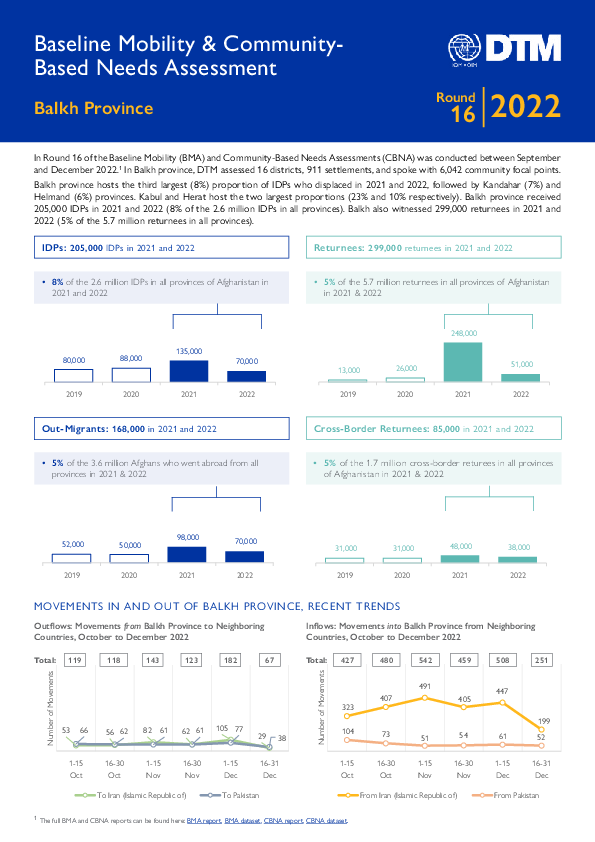
Contact
DTMAfghanistan@iom.int
Language
English
Location
Afghanistan
Period Covered
Sep 01 2022
Dec 31 2022
Activity
- Mobility Tracking
- Site Assessment
- Baseline Assessment
DTM has been conducting the Baseline Mobility Assessment (BMA) in Afghanistan since 2016 to track mobility, provide information on population estimates, locations and geographic distribution of displaced and returnee populations, reasons for displacement, places of origin and periods of displacement. The Community-Based Needs Assessment (CBNA) provides a comprehensive overview of the evolving vulnerabilities and multisectoral needs in communities hosting internally displaced persons (IDPs) and returnees from abroad.
Data is collected at the settlement level through focus group discussions with community focal points and direct observation. The figures presented in the report are estimates provided by community focal points.
This factsheet delves into the key findings in Balkh province using the latest results from Round 16 (Sep to Dec 2022) of the BMA and CBNA, focusing on the 2021-to-2022 period.
The full report can be found here: Baseline Mobility Assessment and Community-Based Needs Assessment.
This document is a compilation of data collected by IOM from FRONTEX as well as the Italian, Spanish, Greek and Maltese interior ministries on migratory movements from Africa to Europe between 2017 and March 2023. IOM works closely with a wide range of actors, including government and non-government partners, to collect and compile this data on a quarterly basis.
This document presents the situation of migrant arrivals in Europe based on data for 2021 from the point of view of movements from West and Central Africa (WCA).

Contact
DTM Europe, DTMMediterranean@iom.int
Language
English
Location
Sweden
Period Covered
Apr 03 2023
May 15 2023
Activity
- Survey
This is the Executive Summary in Swedish and English of the report available at this link.
This report is based on a survey developed by IOM to offer an overview of the living conditions, intentions, needs, and integration challenges of displaced persons from Ukraine1 in Sweden at the beginning of the second year of implementation of the temporary protection (TP) directive in the country.
Commissioned by the Swedish Government and coordinated by the Swedish Government’s Offices, it was conducted between April and mid-May 2023 online and through phone interviews to overcome potential biases and increase the strengths inherent in these two data collection methods.
The total sample is composed of 4,746 adult respondents, which is about 19 per cent of the total reference population of adults with a TP permit in Sweden as of mid-March 2023. Of them, 4,682 are Ukrainian nationals and 64 are Third-Country Nationals (TCNs). The size of the sample as well as the depth of qualitative comments accompanying the replies to closed-ended questions make this study a unique source of data and information on the overall reception system in the country, provided by the direct beneficiaries
1. The terms ‘displaced persons from Ukraine’, ‘TP residence permit’s holders’, ‘respondents’ are used interchangeably to refer to refugees fleeing from Ukraine, either Ukrainians or TCNs, who have been granted a TP status in Sweden, who are the target population of this study.

Contact
DTM DRC, iomdrcdtm@iom.int
Language
French
Location
Democratic Republic of the Congo
Period Covered
Jun 17 2023
Jun 25 2023
Activity
- Event Tracking
Ce rapport présente les résultats des évaluations menées dans les différentes zones de déplacement et de retour entre le 17 et le 25 juin 2023. L'analyse de la crise de juin a permis à la DTM d'identifier un total de 838 947 personnes déplacées par la crise M23. La population déplacée comprend les personnes déplacées dans les sites spontanés et planifiés (470 021 ou 56%), les centres collectifs (38 538 ou 5%), et les personnes déplacées résidant dans les communautés d'accueil (330 388 ou 39%). Le nombre de déplacées de ce cycle d’évaluation est supérieur aux chiffres rapportés dans le dernier rapport, réalisé en mai, où 783 293 déplacés internes avaient été recensés, indiquant une tendance à la hausse.
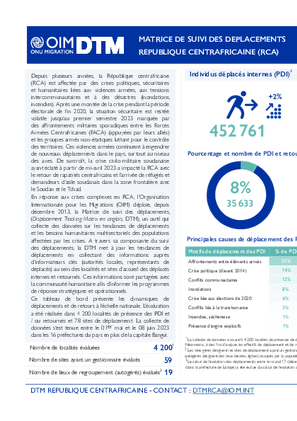
Contact
DTM République Centrafricaine, DTMRCA@iom.int
Language
English
Location
Central African Republic
Period Covered
May 01 2023
Jun 30 2023
Activity
- Mobility Tracking
- Baseline Assessment
Ce tableau de bord présente les dynamiques de déplacements et de retours à l’échelle nationale. L’évaluation a été réalisée dans 4 200 localités de présence des PDI et / ou retournés et 78 sites de déplacement. La collecte de données s’est tenue entre le 01er mai et le 08 juin 2023 dans les 16 préfectures du pays en plus de la capitale Bangui.

Contact
DTM Somalia, IOMSomaliaDTM@iom.int
Language
English
Location
Somalia
Period Covered
Jun 03 2023
Jun 07 2023
Activity
- Mobility Tracking
- Event Tracking
There are 370,390 individuals currently displaced by drought in Gedo region. Since round 65 an estimated 3,726 IDPs arrived at the assessed settlements.

Contact
DTM Somalia, IOMSomaliaDTM@iom.int
Language
English
Location
Somalia
Period Covered
May 27 2023
May 31 2023
Activity
- Mobility Tracking
- Event Tracking
There are 366,819 individuals currently displaced by drought in Gedo region. Since round 64 an estimated 4,077 IDPs arrived at the assessed settlements.
The Horn of Africa and Yemen is one of the busiest and riskiest migration corridors in the world travelled by hundreds of thousands of migrants, the majority of whom travel in an irregular manner, often relying on smugglers to facilitate movement along the Eastern Route. This regional report provides monthly updates on the complex migratory dynamics through Djibouti, Somalia, Yemen and Ethiopia based on diverse data sources and consultations with key informants in the four countries. Moreover, it provides information on the main protection concerns for migrants along the journey, information on spillover effects of the conflict in the Sudan observed at the border with Ethiopia, a specific focus on children and information on the returns from Saudi Arabia to Ethiopia, Somalia and Yemen.
